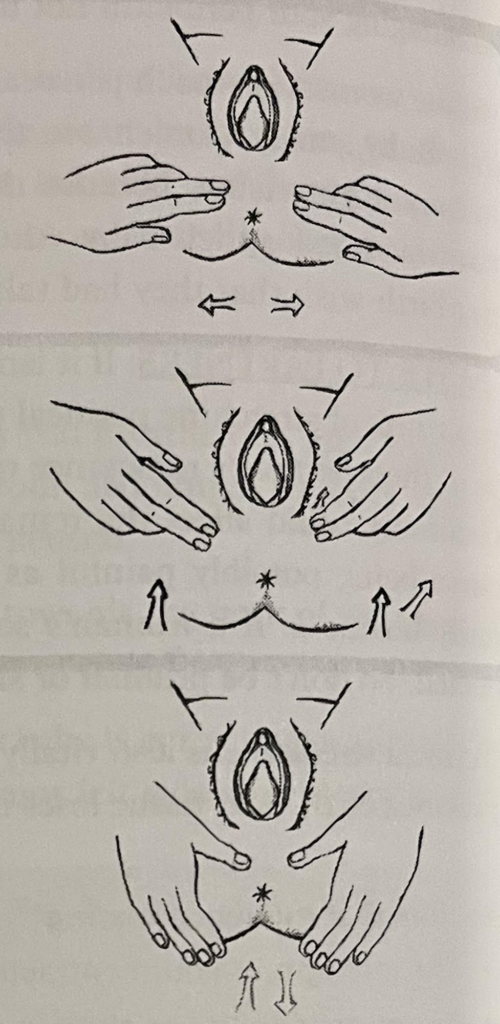What you need to do to prepare for the best birth (and beyond)

WHY IS PERINEAL MASSAGE IMPORTANT?
Let’s be honest from the start, if this is your first pregnancy, then the thought of having to do perineal massage might not thrill you. Some women are tentative-and rightly so because when perineal massage is done properly, it hurts! Literature indicates the benefit of consistently massaging the perineum during late pregnancy as a birthing mother will be less likely to tear during labor. Wouldn’t you agree that encouraging your perineum not to tear is a good thing? Some women approach perineal massage half-heartedly, presuming that all will be fine. Sadly, many women are then unprepared for the likely scenario of an episiotomy during labor, because their pelvic floor and perineum will not relax and accommodate their baby. After hearing countless birthing stories, most women after birth wish that they had taken more time to prepare their bodies for labor.
NOTE TO PARTNERS:
If it isn’t enough that women have to psych themselves up to even think of stretching perineal tissue, some mothers and midwives have informed me of their partner’s reluctance to help. All I can say is this: the scar tissue from an episiotomy could affect the remainder of a mother’s sexual life, with future intercourse being possibly painful as a result. Birthing is not women’s business-it’s family business. If a woman’s sexual pleasure is affected, so will her partner’s. So don’t be prudish or shy, work together.
Perineal stretching is also vitally important if a birthing mother has scar tissue from a previous birth. Scar tissue loses elasticity and generally remains restrictive in nature.
Factors that influence tearing:
- The strength of your contractions.
- The stretch ability or elasticity of your body tissue.
- The size of your baby.
- Position of your baby’s head
- Your position during delivery.
- The speed of your delivery.
- The skill of your attendant.
- Scarring from previous deliveries.
HOW DO I MASSAGE MY PERINEUM?
If you and your partner want to take a natural approach to labor, then you will have to become comfortable with looking at and touching female genitalia.
There is little room for modesty when preparing for childbirth. Watching a birth is a gilt and a humbling miracle but let’s not kid ourselves, it is certainly not glamorous.
If your partner refuses to participate or resists helping you with the massage, then this is a very clear indication that together you need to clarify your birthing preferences and objectives.
As a couple or individually you can use KY jelly, vitamin E oil or jojoba oil for massage.
When you are performing this stretching, it is important to focus on opening up your body. Try to relax, and have confidence in your body’s ability to stretch and give birth to your baby.
When do we start? Begin perineal massage any time from 30 weeks.
How often? If perineal massage is performed correctly (it will hurt); twice a week.
Perineal massage should take 15-30 minutes.
Your mission is to stretch and massage the tissues around your vagina and perineum. To begin, wash your hands well, then lean back into a relaxed position.
Remember, if this stretching doesn’t feel uncomfortable and hurt a little, then you are not stretching firmly enough. So be brave, take a deep breath and relax into preparing your body for a gentle and safe birth.
External Massage:
Locate the area of skin at the centre of your perineum, directly between your vagina and anus. Place your index and middle fingers of both hands opposite each other and pull your fingers out towards your thighs, dragging the skin with you. This creates tissue pull through the superficial layers of skin.
Repeat 10-20 times.
Then turn your fingers in slightly and drag them up towards your pubic hair. Repeat 10-20 times. Then move back to the centre point of your perineum and place the tips of your thumbs opposite each other. Move one thumb up towards your vagina and the other thumb down towards your anus (this feels as delightful as a ‘Chinese burn’!).
Repeat 10-20 times.

Place two fingers inside your vagina and pull down and out slightly. Pull down firmly until you feel a good stretch. Then pull down a little bit more.
Then pull sideways firmly.
Swap hands and stretch the other side. Repeat these three directions 10-20 times.

WHY SHOULD I STRENGTHEN MY PELVIC FLOOR?
Your pelvic floor muscles are the muscles right between your legs. They make a figure of eight loop surrounding the urethral and vaginal sphincters and the anal sphincter at the rear. Unlike your uterus, these muscles are under your conscious control and need strengthening. Irrespective of your birth outcome, be that vaginal or caesarean, all pregnant women need to strengthen their pelvic floor.
A recent Norwegian study suggests that while there may be a small increased incidence of pelvic floor damage among women who deliver their babies vaginally, the major risk factors are a hurried second stage of labor, forceps delivery and epi-siotomy-not natural vaginal birth per se.
THE BENEFITS OF STRENGTHENING THESE MUSCLES DURING PREGNANCY:
• Being able to relax your pelvic floor during labor
If you practice strengthening these muscles, you will develop an awareness of where they are so that during labor vou can consciously relax this area.
To speak frankly, this will be highly useful when your midwife turns to you as your baby’s head is crown-ing, and says, “Now just let your vagina relax, let it go.” She says this just as your perineum fills with the weight of your baby’s head and you feel your body stretch to accommodate for something the size of a
frozen chicken. You will then look at her in absolute horror and confusion.
You need to strengthen these muscles in order to relax them during the crowning stage of labor.
- Better circulation promotes better healing
Exercising a muscle brings more blood to an area and promotes better circula-tion. Having efficient blood supply to your pelvic floor will enable these muscles to stretch easily during labor and allow for quick healing post-birth.* - To prevent vulval or anal varicosities (hemorrhoids) during labor
A strong pelvic floor prevents sphincter weakness and the occurrence of subsequent hemorrhoids. The pressure on your pelvic floor during labor and the engorgement of these tissues post-labor will encourage hemorrhoids if your pelvic floor is weak. - Helps prevent constipation
At some point after giving birth you will have to use your bowels. Unconsciously you may resist this urge through fear. Many mothers post-birth feel anxious that it may hurt or they may cause themselves grave injury. A weak pelvic floor encourages such fear.
ADVANTAGES OF STRENGTHENING YOUR PELVIC FLOOR POST-NATALLY:
Failing to strengthen your pelvic floor during pregnancy encourages a weakness post-labor which, over time, can be exaggerated. Complacency sets in and Pelvic floor Dysfunction (PFD) becomes a daily reality. Then as women age, they often wonder why their body feels so different.
A strong pelvic floor helps prevent the symptoms of PFD, which include:
– urinary urgency or urinary incontinence (the inability to control your bladder)
– the need to urinate frequently, a common complaint amongst women post-birth.
Urination depends on muscle coordination between the bladder and the pelvic floor muscles. These muscles are meant to relax while the bladder contracts.
However with PFD, the pelvic floor muscles continue to tighten when the bladder contracts. The result is poor urine flow. Straining and pushing to get the last drop of urine out is believed to further aggravate the muscles of the pelvic floor, resulting in a vicious cycle.
- A strong pelvic floor helps to increase or improve the sensations experienced when making love. PFD can lessen these sensations.
- PFD can result in a prolapsed uterus, where the uterus is no longer positioned correctly and specialist intervention may be required.
There are some wonderful products now on the market to assist with pelvic floor awareness. One such product is “EPI-NO’ by Tecsana, a home training device which helps to prevent perineal injuries and incontinence.
PREPARE YOUR NIPPLES FOR BREASTFEEDING BY GENTLY PINCHING AND ROLLING THEM
These techniques help prevent nipples becoming too sore when first breastfeeding. These methods also familiarize a woman with handling her breasts and can be performed on both sides for two minutes a day in the last four to six weeks.
A mother can prepare her nipples by not wearing a bra and exposing the nipples to the gentle friction of clothes, also by exposing the nipples to sunlight for a few minutes a day. Rubbing the nipples with wheatgerm oil or expressed colostrum (late in pregnancy) is another important preparatory step.
Don’t rub your nipples with a towel or a brush in an attempt to toughen them, as this will merely rub off skin cells and leave your nipples tender. Also avoid washing your nipples with soap as this will cause them to dry out and promote cracking when they are later stretched.
TO PREPARE NIPPLES FOR BREASTFEEDING:
Pinching: Using your thumb and forefinger, gently squeeze just behind the nipple. If your nipple does not protrude, gently pull them outward.
Rolling: Once you have pinched, roll your nipple between your thumb and forefinger, gently stretching it forward out of your breast.
If you have any questions, please get in contact with us and good luck!